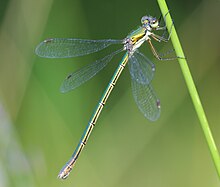Little rush maiden
| Little rush maiden | ||||||||||||
|---|---|---|---|---|---|---|---|---|---|---|---|---|

Little rush damsel ( Lestes virens ), male |
||||||||||||
| Systematics | ||||||||||||
|
||||||||||||
| Scientific name | ||||||||||||
| Read virens | ||||||||||||
| ( Charpentier , 1825) |
The little rush maiden ( Lestes virens ) is a dragonfly of the genus of the rush maiden ( Lestes ) and belongs to the family of the pond maiden (Lestidae). In Central Europe only the subspecies Lestes virens vestalis Rambur , 1842, occurs, two other subspecies in the Mediterranean area.
description
These dainty dragonflies reach a wingspan of 3.5 to 4 centimeters. Your thorax is light blue in the lower part (uncolored: yellowish), and metallic-green on the upper side. The abdomen is greenish to black-green above. The bluish wax tires on the base of the abdomen and the slightly thickened end of the abdomen of the males are comparatively less pronounced than other Lestes species and can also be completely absent. At the back of the head there is a sharp separation of the coloration - at the top it is darker, while the lower part of the head is light yellow. The wing marks are brown in colored animals and have lighter edges on their narrow sides.
Similar species
Small rush virgins are to be confused with other rush virgin species ( Lestes spec.), But are overall more delicate than these. The otherwise similar (unpiped) willow damsel is also much stronger and also has uniformly light markings on its wings. The pterostigma is generally an important distinguishing feature: in the case of the common and the shiny rush virgin , this is black, for the southern rush virgin, two-colored (brown on the inside, lighter on the outside).
Occurrence
The species occurs in large numbers in stagnant , sun-exposed waters with stocks of sedges and rushes , especially in boggy habitats. Particularly in the north-western part of their overall area, i.e. also in Germany, there seems to be a close connection to oligo- to mesotrophic , often somewhat acidic waters (e.g. heather ponds ). The flight time in Central Europe extends from June / July to October; thus the little rush damsel is the latest species of the year within its genus. In Germany the little rush virgin is only scattered and is considered to be endangered. The total distribution area extends over large areas of Europe; however, this species is largely absent in Scandinavia and the British Isles.
Way of life
The behavior of the little rush maiden is very similar to that of the other rush maiden. The adults are usually found sitting on blades of grass at a height between 50 and 80 centimeters and sunbathing. This is also where copulation takes place in the pairing wheel . The approx. 1.4 mm long eggs are pricked into vertical plant stalks protruding from the water, for example from rushes and swamp rushes . The animals do not climb under the surface of the water. After the males have initially accompanied the females as they lay their eggs, they break away from them in the further course. The duration of the coupling obviously depends on the male density in the habitat. Towards the end of the flight season in late autumn, an increasing number of specimens drowned on the surface of the water.
Larval development
The larvae need to develop strong, shallow landing areas with loose to moderate dense vegetation, such as Ried of Carex rostrata or ordinary bulrush . They hunt water fleas, hippos, mosquito larvae, mussel crabs and rotifers, among other things. Depending on the water temperature, they need two to three months to transform into an imago.
literature
- Gerhard Jurzitza: The Kosmos dragonfly guide . - Franckh-Kosmos Verlags GmbH & Co., Stuttgart, 2000. ISBN 3-440-08402-7
- Klaus Sternberg & Rainer Buchwald (eds.): The dragonflies of Baden-Württemberg. Volume 1: General part, dragonflies (Zygoptera). - Ulmer-Verlag, Stuttgart, 1999. ISBN 3-8001-3508-6


